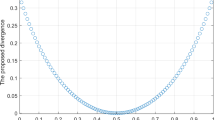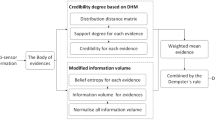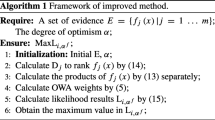Abstract
In this paper, a new algorithm of noise reduction for image based on evidence theory is proposed. The values of all pixels are restricted in interval [0, 1], and set of data in each column is a term of mass function, which can be calculated by D–S composition rule. Judging noise can be achieved by comparing with the value of pixel in middle and of the current one. The noise will be removed by substituting the current value with value computed. An improved accelerated algorithm is also presented by sample window of 2 × 2. As a measure of conflict K with greater value shows that there would be noises within the current sample window. At last, Experiment image “Lena” with additive noise shows as a test sample, that better result can be achieved with the algorithm.






Similar content being viewed by others
Explore related subjects
Discover the latest articles, news and stories from top researchers in related subjects.References
Sun T, Ding S, Chen W (2014) Reduced-reference image quality assessment through SIFT intensity ratio. Int J Mach Learn Cybernet 5(6):923–931
Deschrijver G, Kerre EE (2003) On the relationship between some extensions of fuzzy set theory. Fuzzy Sets Syst 133(2):227–235 Cover image
De A, Guo C (2014) An image segmentation method based on the fusion of vector quantization and edge detection with applications to medical image processing. Int J Mach Learn Cybernet 5(4):543–551
Oberkampf WL, DeLand SM, Rutherford BM, Diegert KV, Alvin KFA (1999) New methodology for the estimation of total uncertainty in computational simulation. Conference: AIAA Forum on Non-Deterministic Approaches, 1999
Zadeh LA (1978) Fuzzy sets as a basis for a theory of possibility. Fuzzy Sets Syst 1(1):3–28
Liu Wang-jin (1982) Fuzzy invariant subgroups and fuzzy ideals. Fuzzy Sets Syst 8(2):133–139
Rodriguez RM, Martinez L, Herrera F (2012) Hesitant fuzzy linguistic term sets for decision making. IEEE Trans Fuzzy Syst 20(1):109–119
Xia M, Xu Z, Liao H (2013) Preference relations based on intuitionistic multiplicative information. IEEE Trans Fuzzy Syst 21(1):113–133
Yang M, Zhang L, Feng X, Zhang D (2014) Sparse representation based fisher discrimination dictionary learning for image classification. Int J Comput Vision 109(3):209–232
Guo G, Chen S, Chen F (2012) Soft subspace clustering with an improved feature weight self-adjustment mechanism. Int J Mach Learn Cybern 3(1):39–49
Ruthven I, Lalmas M (2002) Using Dempster–Shafer’s theory of evidence to combine aspects of information use. J Intell Inf Syst 19(3):267–301
Jones L, Beynon MJ, Holta CA, Roy S (2006) An application of the Dempster–Shafer theory of evidence to the classification of knee function and detection of improvement due to total knee replacement surgery. J Biomech 39(13):2512–2520
Dempster AP (1967) Upper and lower probabilities induced by a multi-valued mapping. Ann Math Stat 38(4):325–339
Yager RR (2009) Comparing approximate reasoning and probabilistic reasoning using the Dempster–Shafer framework. Int J Approx Reason 50(5):812–821
Basir O, Yuan XH (2007) Engine fault diagnosis based on multi-sensor information fusion using Dempster–Shafer evidence theory. Inf Fus 8(4):379–386
Lin TC (2008) Partition belief median filter based on Dempster–Shafer theory for image processing. Pattern Recogn 41(1):139–151
Hua ZS, Gong BG, Xu XY (2008) A DS-AHP approach for multi-attribute decision making problem with incomplete information. Expert Syst Appl 34(3):2221–2227
Liu Ming, Zhang Fan, Datseris Philip, Huang H (2014) Improving finite state impedance control of active-transfemoral prosthesis using Dempster–Shafer based state transition rules. J Intell Rob Syst 76(3–4):461–474
Ma W, Jiao L, Gong M, Li C (2014) Image change detection based on an improved rough fuzzy c-means clustering algorithm. Int J Mach Learn Cybern 5(3):369–377
Zadeh LA (2014) A note on modal logic and possibility theory. Inf Sci 279(20):908–913
Guo K, Li W (2011) Combination rule of D–S evidence theory based on the strategy of cross merging between evidences. Expert Syst Appl 38(10):13360–13366
Bloch I (1996) Some aspect of Dempster–Shafer evidence theory for classification of multi-modality medical images taking partial volume effect into account. Pattern Recogn Lett 17(8):905–919
Boston JR (2000) A signal detection systembased on Dempster–Shafer theory and comparison to fuzzy detection. IEEE Trans Syst Man Cybern Part C 30(1):45–51
Lin TC (2011) Decision-based fuzzy image restoration for noise reduction based on evidence theory. Expert Syst Appl 38(7):8303–8310
Corpetti T, Planchon O (2011) Cover image front detection on satellite images based on wavelet and evidence theory: application to the sea breeze fronts. Remote Sens Environ 115(2):306–324
Zadeh LA (1997) Toward a theory of fuzzy information granulation and its centrality in human reasoning and fuzzy logic. Fuzzy Sets Syst 90(2):111–127
Smets P (1990) The combination of evidence in the transferable belief model. IEEE Trans Pattern Anal Mach Intell 5(12):447–458
Acknowledgments
This paper is supported by the National Natural Science Foundation of China (Grant No. 61300121, 51274144, 61170107,), by Natural Science Foundation of Hebei Province (No. A2014210140, A2013208175), by Training Program for Leading Talents of Innovation Teams in the Universities of Hebei Province (LJRC022).
Author information
Authors and Affiliations
Corresponding author
About this article
Cite this article
Zhao, Y., Mi, Js., Liu, X. et al. Reconstructing images corrupted by noise based on D–S evidence theory. Int. J. Mach. Learn. & Cyber. 8, 611–618 (2017). https://doi.org/10.1007/s13042-015-0353-6
Received:
Accepted:
Published:
Issue Date:
DOI: https://doi.org/10.1007/s13042-015-0353-6




